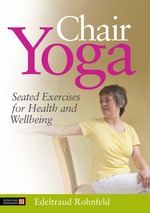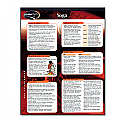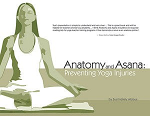| Description |
Chair yoga is a revolutionary concept designed to make the numerous benefits of classical yoga available to a wider range of physical abilities. This step-by-step program can be practiced by virtually anyone, anywhere, in any chair, to stimulate physical and mental well-being. This fully illustrated guide contains ninety easy-to-master exercises that have been specially developed for those with a limited range of movement. Clear instructions guide the reader through each routine, all of which can be carried out safely without any previous knowledge or yoga expertise. The exercises can also be adapted by yoga teachers who want to incorporate chair yoga into their classes. This book will be popular with anyone wanting to experience the health benefits of an easy, versatile form of yoga, particularly the elderly, individuals rehabilitating after injury or illness, those with physical disabilities, as well as the professionals who support them. Contents Acknowledgements. Introduction. What is chair yoga?. Why do yoga today?. The exercises. 1. The Importance of Breathing Practice. Pranayama control of the breath. The breathing exercises. Mahat Mudra breathing into the separate parts of the lungs. 1.1. The inferior front part of the lungs (Adham Pranayama). 1.2. The middle front part of the lungs (Madhyam Pranayama). 1.3. The superior front part of the lungs (Adhyam Pranayama). 1.4. Full yogic breathing (Mahat Yoga Pranayama). Breathing into the side and back parts of the lungs. 1.5. The lower side and back region of the lungs. 1.6. The middle part of the side and back region of the lungs. 1.7. The upper side and back region of the lungs. 1.8. Savitri Pranayama. 1.9. Alternate nostril breathing (Surya Bhedana Pranayama). 2. Exercises for the Feet and Toes. 2.1. Raising the heels. 2.2. Rocking on the soles of the feet. 2.3. Rolling the feet. 2.4. Waking up the feet. 2.5. Loosening and spreading the toes. 2.6. Clenching the toes. 2.7. Stretching the feet. 2.8. Walking on tiptoe and on the heels. 3. Exercises for the Legs. 3.1. Pushing the knees sideways. 3.2. Massaging the legs. 3.3. Bending the legs. 3.4. Making circles with the heels. 3.5. Wind-releasing exercise (Pavanmuktasana). 3.6. Clapping under the legs. 3.7. Bicycling. 3.8. Stimulating lymph flow in the lower part of the body. 3.9. Boat pose. Variation 1 (Navasana). Variation 2 (Nava Kriya). 4. Exercises for the Fingers, Hands and Wrists. 4.1. Interlacing the fingers (an exercise to develop skill). 4.2. Pressing the fingertips together. 4.3. Locking the fingers together. 4.4. Pressing the palms of the hands together. 4.5. Moving all the fingers separately. 4.6. Making circles with the fingers. 4.7. Fingertips touching. 4.8. Spreading out the fingers / making fists. 4.9. Opening the hands. 4.10. The Bud. 4.11. Exercise for the wrists. 4.12. Bending the wrists. 4.13. Stretching the hands. 5. Exercises for the arms. 5.1. Making circles with the arms. Variation 1. Variation 2. 5.2. Extending the elbows. 5.3. Widening the chest. 5.4. Relaxing the rib-cage. 5.5. Crossing your arms. 5.6. Stretching the arms. 5.7. Harmonizing exercise. 5.8. 'PAH' exercise loosening up the arms. 5.9. Mountain pose upward stretch. Variation 1. Variation 2. 5.10. Clapping your hands above your head. 5.11. Stretching the arms and letting them go. 5.12. Pushing the walls apart. 5.13. Pushing weights. 6. Exercises for the Back. 6.1. Dance pose (Natarajasana). 6.2. Twisting forward bend. Variation 1. Variation 2. 6.3. Half spinal twist (Matsyendra Asana). 6.4. Tiger breathing. 6.5. Back and arm extension. Variation 1. Variation 2. 6.6. Spinal twist with arms bent. Variation. 6.7. Spinal twist with outstretched arms.6.8. Lateral extension. 6.9. Back flexion with leg extension. 7. Exercises for the Shoulders, Throat und Neck. 7.1. Propeller. 7.2. Dropping the shoulders. 7.3. Circling with the shoulders.Variation 1. Variation 2. 7.4. Massaging the shoulders. 7.5. Shoulder stretches. 7.6. Head leaning to one side. 7.7. Turning the head slowly (Brahma Mudra). Variation 1.Variation 2. 7.8. Shoulder rotation. 8. Standing Exercises (Some With a Chair, Some Without). 8.1. Half- (or crescent-) moon. 8.2. The crane. 8.3. Walking with a spring in your step. 8.4. Circling the knees. 8.5. Circling the hips. 8.6. Circling the upper body. 8.7. Variation on standing twist (Dola Dolati, 'pendulum'). 9. Exercises for Both Sides of the Brain. 9.1. 'Clang' exercise. 9.2. 'Gong' exercise. 9.3. Raising opposite arm and leg. 9.4. Hand-to-knee cross-patterning exercise.Variation 1.Variation 2. 9.5. Balancing pose.9.6. Horizontal figure-of-eight. 10. Pelvic Floor Exercise. 10.1. Tensing the muscles of the pelvic floor. 11. Exercises for the Eyes. 11.1. Energizing the eyes.11.2. Head and face massage. 11.3. Circling around a dot. 11.4. Watching a pendulum. 11.5. Exercising the eyes. 12. Relaxation. Conscious relaxation. Leading a yoga group. 13. Exercise Guidelines. Planning a chair yoga session. Fifteen-minute yoga programmes. Programme 1. Programme 2. Programme 3. Programme 4. Thirty-minute yoga programmes. Programme 1. Programme 2 (with standing exercises). Programme 3. Programme 4 (with standing exercises). Forty-five-minute programmes. Programme 1. Programme 2. Programme 3 (with standing exercises). Programme 4 (with standing exercises). Sixty-minute programme. More About Yoga. The 'eight-fold path'. 1. Yamas (general restrictions). 2. Niyamas (observances). 3. Asana (pose, posture). 4. Pranayama (extension of the breath / energy). 5. Pratyahara (withdrawal of the senses). 6. Dharana (concentration/composure). 7. Dyana (meditation/higher awareness). 8. Samadhi (being-at-one, ecstasy). Diet. The right diet not just for reasons of health. Why organic foods are preferable to those produced by conventional agricultural methods. Why wholefoods are more nutritious and health-giving than foods made with refined flour. Why we should think again about eating meat. 'Rich people's meat is poor people's hunger'. Sprouting seeds green shoots from grain. Why sugar is harmful. Nuts. Water. Coffee and black tea. Why garlic is healthy. Why I Wrote this Book. Index. Author information Edeltraud Rohnfeld qualified as a yoga teacher at the Berlin Yoga Institute Asha Rekai in 1991. She taught private yoga classes in Berlin for 15 years and trained yoga teachers and healthcare professionals. She later specialised in chair yoga, learning from its founder Erika Hammerstroem. She moved to Ireland in 2008 where she runs seminars on chair and classic yoga. Her website can be viewed at www.yoga-clare.com. Reviews "Chair Yoga is a welcome addition to our yoga library it will be a boon to our aging population who are often worried about starting yoga in case they are too stiff to keep up with the rest of the class. This is the book that I have been waiting for. I will now be able to help so many more people who require a more gentle approach to yoga. I am going to recommend it to all my pupils with mobility problems." - Barbara Currie, yoga expert and creator of numerous yoga dvds and books "A perfect guide to yoga for people with limited mobility. The clearly explained, gentle chair exercises promote strength and flexibility, and open the benefits of yoga to all. Chair Yoga keeps muscles strong, joints flexible, minds alert, and improves balance...Beautifully written and accessible, this is a gem of a book." - Annette Wellings, Pilates instructor and author of Curves, Twists and Bends: A Practical Guide to Pilates for Scoliosis
|




